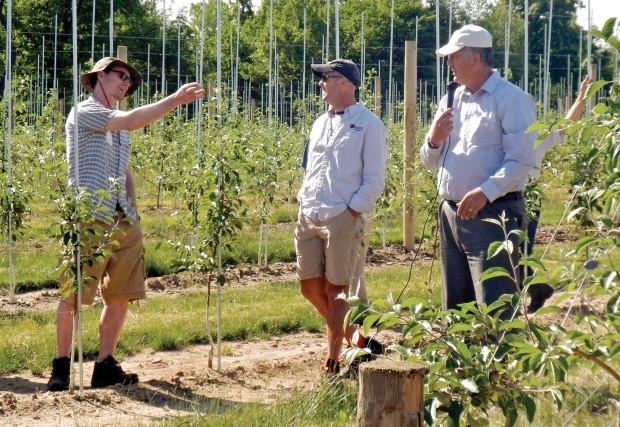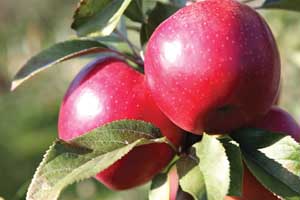
Growers of two new New York apple varieties are having problems meeting their marketing goals, especially for the sweeter, Honeycrisp-like apple named SnapDragon.
SnapDragon (NY 1) and RubyFrost (NY 2) were bred at Cornell University in Geneva, New York, especially for New York growers.
What is SnapDragon?

New York apple breeder Dr. Susan Brown answered questions about SnapDragon (NY 1) in the latest RosBREED newsletter:
What is the pedigree of SnapDragon?
SnapDragon is a cross of Honeycrisp and a New York advanced selection whose parents were Golden Delicious and a New York cross of Monroe and Melrose.
How was it developed?
The cross was made at Cornell University, Geneva, in 1998. The seedling first fruited four years later. It was from a cross of 381 seedlings, several of which have commercial potential.
This cultivar was the first tree in a long row, and when we sampled it at the start of our evaluations, I teased my assistant that we couldn’t select the first tree in the row. We noted it, went back again, and quickly decided that it was special and it would be propagated on a fairly large scale the first year of testing (which is unusual).
Fast-tracking this selection shortened the period from cross to negotiating commercialization rights to 11 years—one of the fastest times for an apple cultivar to be commercialized.
What makes SnapDragon so special?
SnapDragon is a very precocious, productive tree. Fruit has exceptional quality, with crisp texture, good juiciness, high soluble solids concentration and pleasant aromatic flavors. (Photo courtesy Robin Leous, New York Apple Growers)
Trees in the second leaf are not ready to bear any fruit and trees even in their third year must be highly restricted in the number of fruit allowed on each tree.
This has slowed down the introduction of the variety to retail stores.
There was a lively discussion about that during the Lake Ontario Summer Fruit Tour in Wayne County, New York, in June. Growers were visiting Bob and Dave Coene’s Windmill Farms orchard, looking at trees that were a full year smaller than theory says they should be.
The major conversation was between two people: Dr. Terence Robinson, the Cornell University pomologist who’s the leading developer, advocate, and “philosopher” for the tall-spindle growing system and a huge fan of SnapDragon, and Mark Russell, the Niagara County grower who is the new chairman of the marketing committee for the grower organization that has exclusive rights to grow and market SnapDragon and RubyFrost.
The organization growing the apples, originally named NYAG, for New York Apple Growers, was recently renamed Crunch Time Apple Growers.
Robinson offered some practical advice for SnapDragon growers—but also pointed to the conservative approach of the 140-grower organization that grows them.
First, the criticism
Robinson said the goals—to plant 950 acres of SnapDragon and RubyFrost with about 1,000 trees per acre and market about 500,000 bushels of each variety each year—were way too conservative. “You should shoot for 5 million bushels,” he said. “If you believe in a product, grow it. SnapDragon is as good as any apple in the market.
“If you go bigger, you can hope to compete against Cosmic Crisp. If you don’t, you’ll have a niche apple that may be swamped in the market by Cosmic Crisp.” Cosmic Crisp is the apple developed by Washington State University and introduced as WA 38, a proprietary variety to be produced, initially, only by Washington State growers.
Russell told Good Fruit Grower that the overwhelming concern of the growers who decided to invest in SnapDragon and RubyFrost was that the apples be profitable, and the path to that was to control supply, quality, and price.
While initial production goals were modest, the plan was to “listen to the market and evaluate before going to a next step.”
The Crunch Time Apple Growers were trying a new marketing model as well and wanted to make sure it works. “We’re not a one-desk club apple, and we’re not multi-regional either. Both these things make us unique,” Russell said.
So only New York growers will be growing the apple, and a limited group of packers will be packing and selling it. “We wanted to take advantage of and preserve the long-standing relationships between packers and retailers,” Russell said.
This makes coordination more difficult, since quality standards must be uniform among packers and pricing must be uniform among sellers as well.
In the future, Russell said, members of Crunch Time will have to make decisions, and the process needs to be democratic. How many apples can be produced at a profit?
Will existing growers be the only ones allowed to grow them or will more growers be able to buy in, and on what terms? Is being a New York State-only apple a viable idea, or would the market be more stable if other regions also grew the apple?
What is the best approach to marketing a high-quality apple in a world with dozens of new, high-quality apples competing for shelf space and consumer loyalty?
Second, the challenge
Russell said that when the Crunch Time growers were ready to plant, other growers of other varieties were making the same decision to plant. About 80 percent of the 950,000 trees of each variety went in in 2013, 2014, and 2015. While many growers in New York wanted to plant on Geneva rootstocks, they were not available, so growers chose what they could get—Malling 9 and Budagovsky 9.
These two rootstocks were both too dwarfing and too precocious for SnapDragon.
“SnapDragon flowers profusely and M.9 just adds fuel to that fire,” Russell said. The remaining trees—the 20 percent still not planted—will likely go in next year on G.935. RubyFrost, he said, “grows like an ordinary mid-vigor apple tree and growers can use whatever rootstock they’re comfortable with.”
SnapDragon rules
The “new rules” for growing Snap-Dragon, as explained by Robinson, are these:
—Rootstock
Plant trees on G. 935. “That’s better than M.9 or B.9, but even then you have to plant close. Plant more trees per acre and place rows closer together than with other varieties.”
—Cropping
Use of gibberellic acid (GA 4 + 7, ProVide) will inhibit flower bud formation. Robinson said growers should encourage their nursery to use it to inhibit flowering on trees they will plant, and growers should use it to inhibit flowering in the second leaf. “SnapDragon is a flowering fool,” he said.
Robinson acknowledged that his advice on tall-spindle plantings is to get some crop in the second year to start to pay the bills, but that won’t work with SnapDragon.
“Defruit them completely,” he advised. “You can’t crop in the second year and get them to grow.”
Cropping control is also critical in the third year. Aim for no more than five fruit per square centimeter of trunk cross-sectional area. Don’t go beyond 20 apples per tree in year three.
Remove fruit early (before June 15) so as not to divert tree energy to growing fruit when they need to be growing the central leader so they reach the 10-foot wire as early as possible.
—Push the trees
Use intensive irrigation and fertilization. “If you can’t get trees to grow, you won’t have apples to sell. You can’t get SnapDragon to the 10-foot wire in two years. It’s hard to do it in three.”
—Pruning
Single the leader early in June. Remove extra shoots at the terminal and divert the growing effort on the central leader.
“You need to grow that leader,” he said. “Don’t drain the tank and then try to grow the tree.”
Remove large lower limbs. Renewal pruning is an important part of tall spindle orchard management, and it needs to be accelerated on SnapDragon. Removing the largest bottom branch from slow-growing trees will divert energy to the growing terminal.
Russell said that, in managing his trees, “we left all the small shoots alone on our two- and three-year-olds, but cut off everything that looked like a real branch.” •
Online
SnapDragon is a cross of Honeycrisp and a New York advanced selection whose parents were Golden Delicious and a New York cross of Monroe and Melrose. Read more details about the variety as detailed by New York apple breeder Dr. Susan Brown online at bit.ly/GFGsnapdragon






I’m addicted to Snapdragon apples
I’ve the crunch and flavor
I’m always telling all my friends about them.
Best apple by far of any variety. I found them at Costco but they didn’t have them last week. I am hoping to find them again. Would pay any price.
I love the snapdragon apples. They are far superior.
does anyone know who will sell a few trees?
These are great apples, And almost perfect, as far as I’m concerned. I find the skin to be a bit tough. I’m having difficulty linking these with the Honeycrisp, though, which I’ve never found to be very crisp at all. If I want a crispy apple, which I always do, I default to Fuji.
SnapDragon are awesome apples. I also can not stop eating them. I live in the Hudson valley. How can I get a few trees to plant in my yard?
Hi Neil,
Some apple varieties are only available to commercial growers. I don’t know if that’s the case with SnapDragon, but you could check with Crunch Time Apple Growers, the company that grows and distributes SnapDragon: https://crunchtimeapplegrowers.com.
Best apple I ever ate. It is shocking how long they are available in the store. Seems to be an extraordinarily long keeper which is all the better. I eat at least one a day.
I would love to try to plant my own trees as it is a long drive to stores that carry this apple.